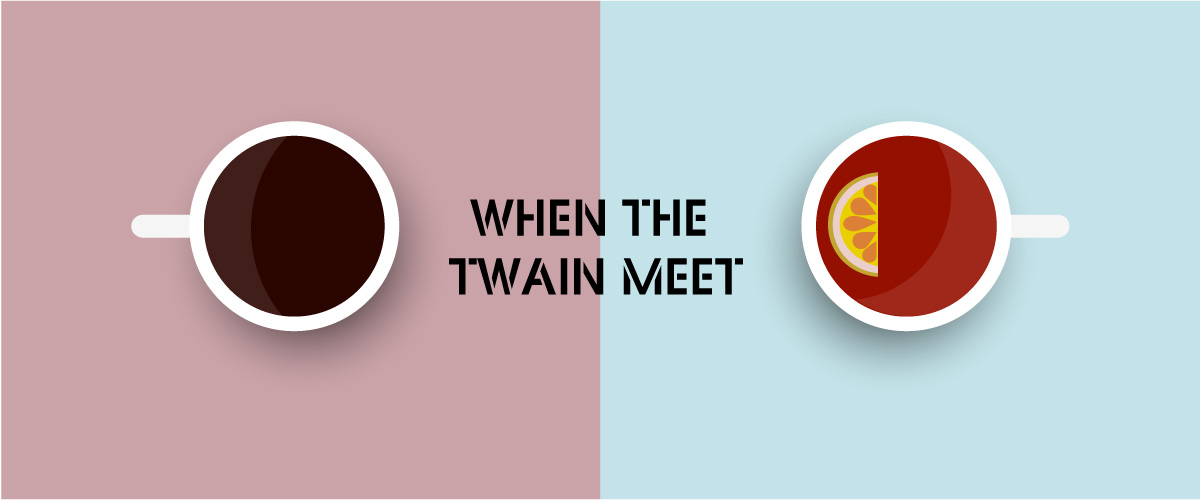Every day tea and coffee vie for the hearts and mouths of people around the world, but did you know this turf war has common ground in several cultures?
Cofftea, my uncle Andrew explained, is simply coffee and tea brewed together. I squinted at him dubiously. Uncle Andrew, a family friend, was famous for his love of chilli and his skill in cooking char kway teow (a Malaysian dish of stir-fried rice noodles—in his case, accompanied by tons of chilli). I was probably about 13 or 14 at the time and reasoned that someone who ate that much chilli could not be in possession of working tastebuds. Coffee and tea together? What was he thinking?
Uncle Andrew’s version of cofftea was created in the crudest possible way. He placed one heaped teaspoon of soluble coffee and one teabag in a mug, then added hot water, milk and sugar before stirring.
It was many years later before I encountered cofftea again. I’d thought of Uncle Andrew as slightly mad so it was not until I saw an Asian lady at a morning tea station put a teabag in a cup then use the pre-made percolated coffee to brew it that I finally realised that cofftea was genuine thing that people purposely drank. Following this stranger’s lead, I made a cup of tea using the percolated coffee. Then I conveniently mislaid the almost-full cup and went off in search of cake.
[bctt tweet=”The birth of cofftea is a disputed one because many people seem to have created it independent of one another, either by accident or by design.”]
After that I saw versions of cofftea in Asian grocery stalls but never thought to try it again, until I did by accident. My brother and I were having breakfast at a kopitiam in Singapore and they didn’t have teh tarik, so to sate my curiosity I chose an item on the menu that I’d never had before: yuanyang. It had the strong tannins and sweetness of Hong Kong style milk tea but some other mystery ingredient.
A web search later revealed that yuanyang is three parts kopi (Malaysian coffee) and seven parts teh c (sweet tea with evaporated milk) and is also known as kopi cham (‘coffee mix’). The drink is called yuanyang, meaning ‘a pair of mandarin ducks’, because the male and female mandarin duck look completely different but mate for life: an unlikely combination, but a complementary one.
Even more recently I saw a menu item for a ‘dirty chai’. Upon enquiring, I learnt this is chai (usually a ‘chai latte’ rather than a properly brewed chai) combined with a shot of coffee. It’s less cofftea—with barely a chance to taste tea in the beverage with the amount of competing strong flavours—and more of a flavoured coffee.
Who invented cofftea?
The birth of cofftea is a disputed one because many people seem to have created it independent of one another, either by accident or by design.
There is one reference to a man named Frank Weston who was living in The Netherlands when he experimented with coffee and tea to find the perfect twin brew, but he doesn’t appear on the scene until 1993, well after I knew Uncle Andrew had started imbibing. Weston does seem to have taken the combination seriously, though, with a specific method of brewing the two to optimise flavour using a coffee machine or percolator.
Another reference points to US ‘beverage experimenter’ Sandra Blund who says she has met only one other cofftea drinker, a Cistercian nun who began combining the drinks in 1936—which is about the time the drink appeared on the streets of Hong Kong.
I like to think whoever started cofftea saw the divide between tea drinkers and coffee drinkers as a little bit silly and wanted to unite them in the same way that the inventor of the mocha wanted to please drinkers of coffee and hot chocolate in one cup. Unfortunately, cofftea does not enjoy the same symbiotic taste relationship as a mocha, so although this tea drinker does enjoy the occasional cup of the other brew, she’s going to keep the tea and coffee consumption separate for now.
But in the spirit of adventure, when next asked if you want tea or coffee, why don’t you try both together?
Other names for cofftea
kopi cham (Malaysia)
spreeze (Ethiopia)
teafee or teaffee (USA)
yuanyang (Hong Kong)
PS: At Teabox, we have a coffee-flavored iced tea, the Kopi chia, that you might want to try.


1 Comment
Love this! There is also a local mocha style drink that combines coffee powder and Milo, called Neslo = Nescafe + Milo.